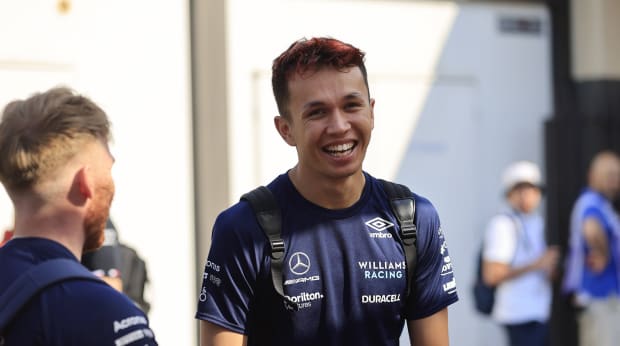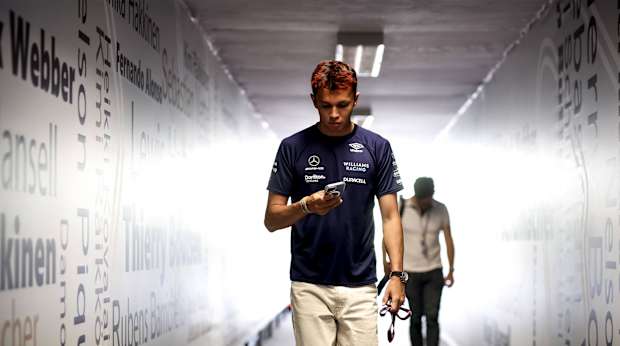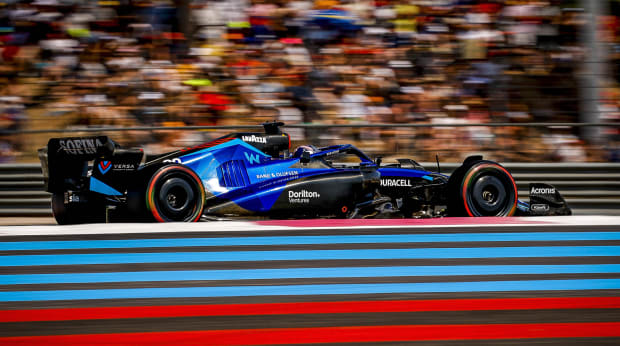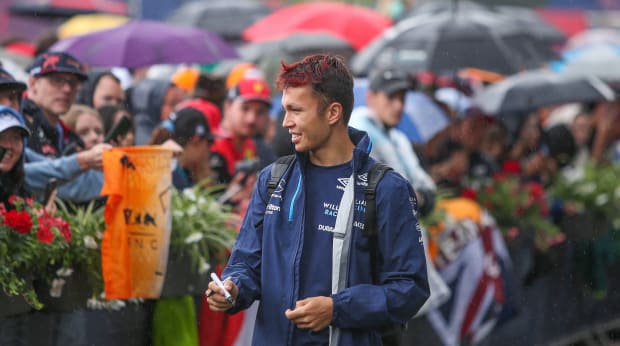With summer break around the corner, the Williams driver broke down what to expect this weekend at the ‘driver circuits,’ his road trip plans and much more.

IMAGO / NurPhoto
Walking through the paddock, there’s plenty that can catch your eye but it’s hard to miss the 6’1” driver with bright red hair.
Alex Albon’s hair has been dyed since the Australian Grand Prix in April after visiting Wat Sakeo Orphanage in Thailand prior to the weekend. More than 2,500 children live there, and the two who showed Albon around were major Liverpool fans. So much so they dyed their hair red to match their red jerseys.
The duo asked if they could dye Albon’s hair, and the rest is history. Since that moment, the 26-year-old has sported red hair, and coincidentally, he had a string of high finishes—P10 in Australia, P11 in Imola and P9 in Miami.
He says he hasn’t dyed it since Barcelona, but the red hair is still vibrant. Albon has considered switching up the colors, possibly a K-pop white. Time will tell, but regardless of the hair color he chooses to sport, it’s hard to miss the Williams No. 23 zipping through the grid, looking comfortable as ever.
Albon, who was born in London but races under the Thailand flag, hadn’t competed in a normal F1 season since 2019 after the COVID-19 pandemic briefly halted the ’20 campaign, forcing scheduling changes. He made his debut with Toro Rosso (now AlphaTauri) before being promoted mid-season in ’19 to Red Bull, competing side-by-side with Max Verstappen. Albon tallied eight top-six finishes in nine races during the second half of that season, but Red Bull dropped him a season later after ’20.
The young driver, though, was retained as a reserve and test driver, and when a seat opened up as George Russell joined Mercedes for 2022, Albon found his way back onto the grid with Williams.
This season has been a whirlwind as the 10 teams and 20 drivers faced new technical regulations. The adjustments, some of the biggest in F1’s history, were expected to create better wheel-to-wheel action so the cars could follow more closely together. It’s been an adjustment and learning process for a majority of the grid, and Albon feels comfortable in the new set-up.
As Formula One prepares to race in Hungary for the final Grand Prix before summer break, Sports Illustrated spoke with the Williams driver about the “driver circuits,” how there’s more to being a racing driver than steering and pressing pedals and his plans for the hiatus.

IMAGO / HochZwei
Fuel for Thought is Sports Illustrated’s exclusive Q&A with Formula One’s biggest names. The following questions and answers have been edited for brevity and clarity.
Sports Illustrated: How is Budapest?
Alex Albon: It’s good. It’s one of our favorite places to go to. It’s an amazing city, actually, and a lot of history. The circuit as well actually has a lot of history to Formula One. It’s a circuit that they’ve been here for a while now. We call these circuits the driver circuits. So maybe not as exciting to the viewers, but to drive on, it’s very technical, very busy, physically demanding as well. So we, we enjoy that.
SI: Do you have a favorite memory at this circuit?
AA: It’s not often been an amazing track for me. I won here in 2018 back in Formula Two so that was a good race for me, and … my first year here in Formula One I got points in Toro Rosso.
SI: How has it been getting back into the car because you’ve had a year off? But then you have these technical regulations that changed and created a much different car.
AA: It’s very different to previous years. We see it in previous years the way that the rules were made the cars were very refined. You had very complicated suspension systems, very complicated ways to set up the cars, and it made the driving bit very easy, very smooth because it felt almost like computer games in real life, almost robotic in the way that they handled. They were very impressive in that sense. And this year, they’ve gone towards a much more I don’t want to say basic, but it’s much more up to the driver. So a lot of suspension systems, the technology in them, have been removed, and just the way the cars are now, they’re in a place where they’re much more physical. You feel every bump on the circuit. You’re fighting much more with these cars. And I think as a driver, it’s just really split opinion, but in general personally, I enjoy it. It feels like we’re wrestling these cars now rather than before which we’re kind of at one with it.
SI: Is it safe to say you’re comfortable with the car?
AA: Yeah, it’s taken a while to get used to. I don’t know if you’ve seen all the cars bouncing around this year. I think it shocked everyone to begin with. But as Formula One works and as the brains of the teams get behind the cars, they seem to be able to exploit them and figure out ways to help the issues, make the cars go faster. I enjoy it. I feel like it’s made the cars more physical drive as well. It makes us feel like we’re really contributing to the performance of the car. There’s a bit more that the driver has to do to get lap time out of it.
SI: How do you prepare for the physicality aspect of the sport because a lot of people just think, ‘Oh, you’re just turning a wheel,’ but there’s a lot more that goes into it.
AA: Yes, I get that comment often—you just sit and turn a wheel and pedals. And I think that’s maybe the only correlation that we have to a road car. What we’re doing is much more intense. Just to give some examples, we’re in the car for around two hours. Our heart rate on average is about, depending on the drive, it can be from 160 to 180 beats per minute. So, we’re pretty much doing an endurance race. We’re burning over 2000 calories a race, and it’s losing about I guess it must be around four pounds, five pounds of water weight. The way that G force goes into your body, you can’t breathe normally like a normal person. So you have to hold your breath a lot of the time through certain corners. And of course, the cars get hot. We were racing in—I don’t know what it is in Fahrenheit—but it must be touching 100 degrees Fahrenheit in a lot of the circuits that we go to. So they are physical. We train over seven times a week in terms of double sessions or whatever. But it gets tricky for us because, obviously, we’re on the road so much. We’re fighting jetlag all the time. We have a lot of media commitments that we’re doing. It becomes a balancing act between staying fit, keeping our energy and our focus for driving these cars up as well. It’s all tricky.
SI: It’s kind of surprising how energetic y’all are by the time you get to the media commitments because hearing half of what y’all do, I would be exhausted.
AA: Trust me, we got to and we complain all the time so don’t worry about that. There’s often days where we do what we call triple headers, so we three weeks in a row racing, and they can be with time zones, as well. So we can shift four, five, six hours within time zones and racing back-to-back, and it is exhausting. It’s a balancing act because [in] Formula One, there’s only 20 drivers and two drivers per team. So there’s a lot of effort in terms of marketing and communication for the sponsors and whatever it may be. But at the same time, we need to perform, and we need to be fit and healthy when we’re driving. So it is a balancing act. Fortunately for us, we have full-time trainers with us. We have [a] sleep doctor, nutritionists … psychologist. They help us keep our focus and maintain our performance through the year.

IMAGO / PanoramiC
SI: Looking back over last weekend, what stood out about the French Grand Prix that maybe didn’t make the headlines? Because it was your 50th.
AA: It was an O.K. race. We did the best we could. We were fighting for points, which was good for us. [Circuit] Paul Ricard … to be completely honest with you, there’s nothing that truly stands out. I would say if the drivers could rate circuits, I’d be very surprised if that circuit was in the top-five apart from a few who are, obviously, French then maybe it would make a top-five appearance. But as a circuit, it’s actually a testing track. So the real difference about it is the margin of error is actually quite high. You can make a lot of mistakes on that circuit, and you can get by with it because it’s all open. It’s because it’s a testing track. There’s no gravel; the walls are very far away. So you can push the limits of the car very comfortably, let’s say, with knowing that you can get away with mistakes. There are still crashes, and … Charles [Leclerc], he had his off. So it’s still tricky out there. But, that’s the main thing. Other than that … I don’t want to say the best thing because that makes the track sound bad, but it’s about a two hour drive from my apartment so I quite like it.
SI: A short commute is always a plus.
AA: It is, but the traffic at Paul Ricard—if anyone wants to go in the following years, just be prepared for it because the traffic is very bad. That’s all.
SI: Looking ahead to this weekend, what should fans be looking for when it comes to the Hungarian Grand Prix? What part of the track is the most difficult and why?
AA: This circuit, more than anything, what separates it from most circuits is how continuous it is. There’s really no stops between each corner. There’s a lot of corners. I believe there’s 14 corners in the circuit, but they’re very bunched up together. So mentally, it’s very exhausting, actually. It’s a very quick track, and you just need to be in your zone. You need to be quick in your analysis of the circuit and your concentration. Your reactions and everything feel one step above a normal circuit when you come here. So to keep that focus for we do 70 laps around here on Sunday, it gets pretty tricky.
SI: A simple but deep question—who is Alex Albon?
AA: Alex Albon. I’ll say he’s an Asian redhead who enjoys his racing, who doesn’t like too much marketing. He’s come back in F1 and trying to prove people wrong. And I love cats.
SI: What is the one question you wish more people would ask you? And how would you answer?
AA: I don’t know if I want to be asked this question, but it’s more of a statement rather than a question … It’s interesting to me how the media side of Formula One is growing, and it has a lot of positives with it. But there’s a lot of negatives as well. The way that I think social media is going in general with the toxicity within media in general in Formula One is becoming quite clickbait in its approach to this growing new audience. It’s interesting how drivers—everyone’s struggling with it. But it’s different. I don’t know how you would phrase that question, but that would be one thing which I think people don’t realize is we have a lot of pressures in F1 … This explosion of Formula One—the effects is obviously very positive in most senses. I think teams right now are very healthy, and drivers too as the money gets moved around. But in the other side of things, it does bring this different style of noise in Formula One, and I think we take it for what it is. But, it’s different.
SI: What would your advice be to the next generation because they are growing up with a very big boom in social media?
AA: I think it’s very important to have people close to you that tell you the reality of the situation, tell you the truth, what they believe in. I think it’s very important in a sport where there’s 1,000 people working in a team for you to have three or four people that you can close off and you know who are there for you, only for you. Because it is a team sport, but it’s also very individual in the way that we need to perform. I’d say for these young people, that’s a tricky one. It’s not easy to have someone like that early on, and I don’t think you need it for, let’s say, Formula Three or Formula Two. But when you get to Formula One, it’s something which is really important. And then I think stay true to yourself. All the best drivers are critical, but you need to be to enjoy it. And you just need to be confident.

IMAGO / GEPA pictures
SI: Are you excited for summer break? How are you going to be spending it because I’m guessing you’re going to disconnect.
AA: Yes, all of us, we get away from the racing as much as possible. Everyone in the team too. We don’t talk to each other. We’re not actually allowed to talk to each other by regulation, which is a good thing. So for my side, I think the first week, I’m actually on an island. My girlfriend’s competing in a golf tournament so I’m off over there for a week. And then the following week, we’re gonna go on a road trip around Italy. So we’re gonna start in Monaco, which is not in Italy, and drive down to Florence, basically, and spend a week just going up and down the country. That’s about it. Quite relaxing. A bit more driving, unfortunately. I’m gonna have to get my girlfriend to drive half of the time so I don’t get fed up with driving too much.
SI: Are you a backseat driver?
AA: My girlfriend is from L.A., and it’s not that I don’t trust her. I wouldn’t be able to relax if she was in the car driving so it’s better that I drive.
SI: I know what you mean because I am based in the States.
AA: Likewise, I struggle when I drive in America. It’s a different world. You don’t really have a fast lane. You kind of just do your own thing on the highways, and you’ve got all these crossings, intersections, and she’s fine there. And she bosses me around when I’m in L.A., driving around L.A. She says, are you gonna go? Why are you stopping? Why are you doing this; why are you doing that? So I imagine it must be very different for Americans to drive in Europe because we’re quite orderly. But also even like roundabouts. That’s that’s a new thing for a lot of Americans. There’s a whole different story behind roundabouts…They don’t do roundabouts. Straight lines—that’s the American way.
SI: I prefer the roundabouts, for what it’s worth.
AA: If you ever come to Europe, come to Milton Keynes. It’s a city where my family live, and it’s known for roundabouts. They have the highest per square mile. I think it must be the most roundabouts in the world. It has to be, and every mile you would have gone over about three roundabouts. Google Milton Keynes roundabouts, and you’re gonna see a city that has the exact same grid as like San Francisco or L.A. Everything’s straight and horizontal, but instead of intersections, you’re gonna just see literally 1000s of roundabouts. It’s actually more efficient for traffic… To the L.A. governor and to anyone else, any other governors reading, use Milton Keynes as your blueprint for future designs.
More Formula One Coverage: